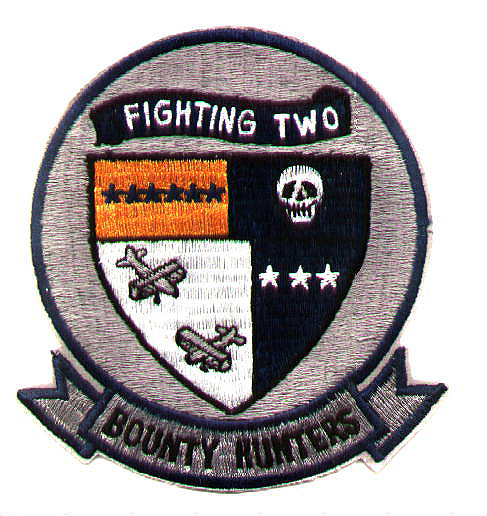

VF-2 Insignia Courtesy of Darryl Shaw |
Established at NAS Miramar at the same time as VF-1 the squadron
completed crew training and received it's first F-14s in July 1973.
Squadron markings in the 70's were among the most colourful of all F-14
units. They composed a blue rudder with two white stars, the 'NE'
tailcode and a blue/white/red sash on the forward fuselage, known as a
"Langley Stripe", in reference to the markings carried by aircraft
flying from the first ever US navy carrier, the USS Langley (CV-1).
Most recent markings seem to be a small 'NE on the rudder and a skull
on the tail.
As with VF-1 the squadron flew top cover over the Saigon evacuation
in Operation Frequent Wind. The squadron formed the TARPS unit for
both CVW-14 and CVW-2, deploying aboard USS Enterprise (CVN-65) at
first, then switching to USS Ranger (CV-61) where they stayed till
1993, apart from a single cruise aboard the USS Kitty Hawk (CV-63) in
1984. Along with VF-1, VF-2 took part in trials of the "splinter"
camouflage in the late 1970's. The CAG bird, BuNo. 158985, was the
only plane repainted as far as I know. For more information please see
VF-1 history.
During it's time as an F-14 operator VF-2 has been highly successful
in the various awards it has collected. These include 3 COMNAVAIRPAC
(Commander of Naval Air Forces Pacific) Battle "E"s during the 1980's.
A Battle "E" signifies the squadron is the most efficient in the Pacific
fleet. VF-2 also won 3 Boola-Boola awards between 1985 and 1987, a
prize given to the squadron that accumulates the most points on it's
annual missile shoot. The coveted Mutha trophy was also won 3 times,
an award presented to the best F-14 squadron in the Pacific fleet. VF-2
has also won awards in the West Coast TARPS, Fighter Derby, ECCM
and High Noon Gunnery competitions.
The squadron became the first to launch an F-14 from an aircraft
carrier while towing an air to air gunnery target, this event occurring
on 2nd of June 1984. In 1987 the squadron logged Ranger's 260,000th
landing. As with VF-1 the unit took part in Desert Storm aboard USS
Ranger, the carrier being one of two forward deployed into the Persian
Gulf. Unfortunately the squadron did not have the opportunity to
engage any Iraqi targets and had to be content with escort, recon and
CAP missions, playing an important part in ensuring the safety of Navy
bombers to and from targets.
When Ranger was decommissioned in 1993 the squadron was left
without a carrier. In 1994 it was decided to make VF-2 one of only
three squadrons that would be lucky enough to upgrade to F-14D Super
Tomcat. Having completed the transition the squadron was assigned to
the newly refurbished USS Constellation (CV-64) and as of March 1994
was completing carrier qualifications along with the rest of CVW-2.
After their 1995 cruise VF-2 returned to NAS Miramar, but were only
in residence for a few months before beginning the process of moving to
the new home of almost all F-14 Tomcat squadrons-NAS Oceana. The
move began in April of 1996 and was completed within a relatively
short space of time.
Once at Oceana VF-2 began training in earnest for their next
deployment. During the later stages of this period the Bounty
Hunters gained F-14's modified to carry the LANTIRN laser
designation pod, giving them an all weather precision strike
capability. Not all squadron aircraft were modified, the usual
being 9 out of 14 (the others being the TARPS capable aircraft in
F-14A & B squadrons, although all F-14D's are TARPS capable).
During this period the F-14 passed 25 years in Navy service. To commemorate
the event Grumman repainted an a F-14D from VF-2 in the 1970's light gull
grey and white camouflage scheme, adding a "25 years-The Cat is Back" logo on the inside
of the tails. The aircraft was BuNo 159630 a F-14A rebuilt to F-14D
standards and one of the oldest still flying. VF-2
received this honour as it is the squadron that has been flying the F-14 longest.
 |
| VF-2 F-14D specially painted to celebrate 25 years of Tomcat operations. |
 |
[Main Page] [F-14A] [F-14B] [F-14D] [Tomcat 21] [Atlantic Fleet Squadron Histories] [Pacific Fleet Squadron Histories] [F-14A Images] [F-14B Images] [F-14D Images] [F-14 Model Kits] [US Navy Air Wings] [A-6 images]